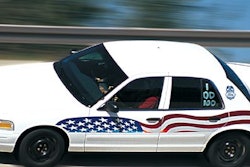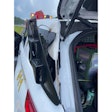You know your agency needs patrol cars, and that some new ones show up every year or so, but you might not be aware of the intricacies of the process. Keeping that process running smoothly could mean the difference between patrolling by car and walking your beat.
Purchasing vehicles might seem like an easy task, but even if your agency only buys them once a year, there's a lot of preparation and follow-up that goes into making sure you'll have a set of wheels on your next shift.
Finding Funding
Of course, the first concern in getting anything purchased at a law enforcement agency is funding. The amount of money you get each year to purchase cars is largely dependent on the money your entire agency is allocated for its annual budget.
The budget approval process usually starts in July, the beginning of the fiscal year for most government entities. A law enforcement agency usually finds out how much money it will be allocated to purchase vehicles for the year in July or August, after the city, county, or state budget has been decided.
Capt. Bob Sedita, fleet manager of the Los Angeles County Sheriff's Department, says his agency has several options for funding.
Primarily, the largest portion of funding for purchasing LASD vehicles comes from LACCALC (Los Angeles County Capital Assets Leasing Corporation). Through this county mechanism, the sheriff's department can amortize the payments for vehicles at a very low interest rate over a three- or five-year period. This allows the department to defer payment for a long period of time.
LASD occasionally receives grants to purchase cars. And sometimes, although rarely, a city that the sheriff's department has a service contract with puts up money to purchase a car for a special purpose.
The Dexter Police Department in Maine receives its funding from town taxes and must get its budget approved by the town council. Servicing a town with a steady population of 4,500, the Dexter PD has two cars available at any given time. While it might not be a huge fleet, it's one the community has to depend on. It can't afford to buy two brand new cars every year to carry out patrol duties.
"We have one car we keep for 18 months as a new one, and the one that was most recently switched out is a spare car," says Dexter's chief of police, David Clukey. "Then we'll switch that out at the end of another 18 months."
Since there isn't much excess money to go around at any law enforcement agency, using older cars until they are no longer serviceable makes good sense.
In fact, most police agencies follow a car replacement schedule, which is part of planning for funding. But you have to strike a fine balance. Buying all new cars every year is too costly, but waiting too long to replace cars can leave you stranded-literally.
Sgt. Evan Hvizdak, fleet manager at the Denver Police Department, advises planning far in advance and factoring in cushions of extra cars, just in case you need them down the line.
Sedita agrees with Hvizdak that planning ahead and prioritizing vehicles is essential to having enough funding each year. "We really have to prioritize. We start tracking vehicles at a certain mileage to make sure they're still cost effective to keep in the fleet. Then we make a replacement projection based on our schedule and submit it to the executives for funding."
Hvizdak's agency uses a numbering system to easily track its cars. "If you have priority classes for a police car, when it's brand new it will be priority "five," he explains. "The year after that, depending on how many accidents it's in and how many miles it has, you recalculate its priority. Once it reaches a priority level of 'one,' it's time to replace it."
Most agencies replace a patrol car at 100,000 miles. If you have a lot of cars coming up on that mark, then you'll have to buy more to replace them. And you'll have to write specs for the new cars you want to take their place.
Writing the Specs
You can't know how much money you'll be able to spend on cars before the administrators sign off on the budget, but don't wait for funding to start writing out your specs.
LASD's Sedita gets his department's paperwork ready ahead of time, according to his long-term vehicle replacement plan, so there's no delay in getting patrol cars on the streets. "We already have our specs all ready to go, so depending on how much money we get and how we're going to divide it among our different needs, then we just plug in a number of each type of vehicle we need that correlates to the amount of money we have to purchase them."
Especially if you're at a larger agency, it could take a very long time to update all of the changes to each type of car the agency purchases each year. A fleet manager is often the person in charge of writing specs.
"The first thing you have to know is what tasks each vehicle has to perform," says Denver PD's Hvizdak. Law enforcement agencies need their cars to perform different duties, and whoever is in charge of writing the specifications for new cars needs to know what details will meet those needs.
"There are differences as you go across the country with the types of use an urban police department might need vs. a rural police department or a highway patrol," Hvizdak says. "The specifications for what they'll call their backbone of their fleet could be entirely different."
Even a standard patrol sedan must meet specific criteria for each agency. What type of partition does your department require for its cars? What width and length of car will be needed to accommodate the type of partition or cage used by your department? Do you use a lot of electronics inside the car? Then you'll probably need a larger battery. How roomy does the interior need to be to comfortably fit all of the equipment that will be added to the car?
Once you figure out what you need your cars to do, you have to determine what specifications will allow the cars to perform those tasks.
Veteran fleet managers might not have any difficulty filling out a checklist of specs to match the duties a car must fulfill because they're so familiar with the process. But if you're part of a smaller agency or if you are new to the job of fleet manager, manufacturers put out books especially for fleet managers-or any interested department-that list the various options available to meet your agency's needs.
If you're a smaller agency just looking into purchasing cars, talk to other agencies in your area to find out how they do things. Find out why they place importance on certain specs. Are there mountainous areas that might warrant a four-wheel-drive vehicle? Will you need more room inside the car for a lot of electronics? Will this vehicle be for a one- or two-person team, and what will that mean?
Writing the specifications is a painstaking process. Hvizdak explains, "You have to write a specification as if the person reading it knows nothing about cars-even to the point of narrowing down what your department needs for the size of the car. The size needs to be defined in terms of the width, the wheel base, the gross vehicle weight rating....All of these things need to be considered."
Once you've decided all of the things you need in your cars and you've written clear specifications, you're ready to put it out for a bid.[PAGEBREAK]
The Bid Process
The Los Angeles County Sheriff's Department (LASD), one of the largest departments in the nation, requires all dealers that want to bid on the agency's car business to register with the county. After the bid has been sent to everyone on the list of registered dealers, other companies can visit the LASD Website, download the bid, and make an offer, but they still have to register before the offer can be accepted. Otherwise, the Department's database doesn't recognize the bid. Because LASD is a well-established department, most dealerships know to register. While smaller departments might not be as well known, the process is much the same. They send their bids to a list of previous bidders and other local dealers.
When you're accepting bids, keep in mind that a local dealer might be more convenient. If you don't have an in-house operation to handle maintenance issues, you'll probably send cars in need of repair to the dealer you bought them from. You won't want to transport them very far if they're already in poor condition.
It takes an average of three weeks for dealerships to respond to an agency with their offers.
Once an agency receives bid offers, the person designated to review them evaluates each bid to find the lowest bidder that meets all of the department's requirements.
When a dealer omits an original request from the bid offer, most agencies pass the dealership over and consider the next lowest bidder. Sometimes a dealership will offer an improvement not requested in the original bid at no extra cost. Most agencies accept this "good exception" gladly.
Once a bid has been accepted, the agency sends the proper paperwork to the dealer that won the bid so an invoice can be generated and the cars can begin going down the production line.
The Finished Product
While cars will arrive at your headquarters with heavy-duty suspension, an extra-large alternator to accommodate many electronics, and any other specifications you requested, they won't be ready to drive on your next shift.
You need to add radios, computer consoles, and any other special equipment to the vehicles.
Whether your agency upfits patrol vehicles in house or sends them out to be fitted with the necessary equipment to turn base model cars into police cars, be sure to make use of lightbars, spotlights, and in-car radios from cars that have been put out of commission. Just because these components aren't brand new, that doesn't mean they won't work on a different car.
Capt. Marc Roberts, director of procurement at the West Virginia State Police, says his agency typically uses each of its lightbars for three or four years before purchasing a replacement. They sometimes use radios for even longer.
In your analysis of how much money each new car will cost, you have to also account for the cost of either buying new accessories or fitting new cars with old components. Both options cost money. "You can figure anywhere from 30 to 40 labor hours per patrol car just to add stuff to it after you take delivery, and that's not unreasonable," says Hvizdak.
Also keep in mind that whether you're going to finish a police car in house or send it out to be upfitted, you have to allow time for the work to get done. And if you're contracting an outside party to do it, you have to expect other customers to be in line ahead of you. Says Hvizdak, "You can't just make a phone call at night and say, 'I need two patrol cars built by tomorrow,' because it just isn't going to happen."
Putting Cars Out to Pasture
When your department decides to take a car out of the fleet, there are several options available.
Smaller departments might put the car out for a bid, much like the process used to purchase a car-except that in this case you're searching for the high bidder. Chief Clukey says the Dexter Police Department even puts an ad in the local newspaper offering to sell its decommissioned cars to any party that offers the best price.
The Denver Police Department often sells police cars to smaller local agencies. Hvizdak believes this can be a very beneficial relationship for both parties, especially if the smaller agency's funds are limited and its officers' physical demands on vehicles are not as high.
Both the West Virginia State Police Department and the Los Angeles Sheriff's Department strip their decommissioned cars of their lightbars, strappings, radios, and police paint jobs, and sell them at auction. Part of the money from auction sales goes back to the respective agency to help start the process all over again next year.
The Purchasing Process
- Funding/budget approved
- Decide which cars you would like to replace
- Decide which cars you can buy with available funds
- Write Specs
- Fill out paperwork and submit bids to local dealers
- Receive offers back from dealers
- Evaluate bids, give job to lowest bidder that meets agency's standards
- Cars delivered to agency
- Add accessories/components to cars
- Evaluate all cars each year and prioritize them for replacement



















